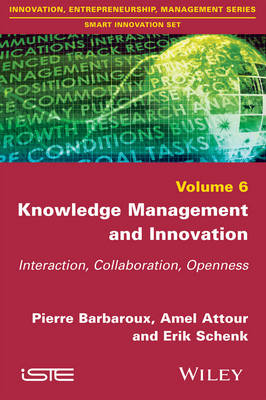
Knowledge Management and Innovation
ISTE Ltd and John Wiley & Sons Inc (Verlag)
978-1-84821-881-9 (ISBN)
The geographical extension of markets and intensification of competition have led firms to experiment with novel approaches to innovation. New organizational forms emerged in which firms collaborate with various stakeholders to create, absorb, integrate and protect knowledge. This book explores how knowledge management processes evolve with firms' implementation of interactive, collaborative and open innovation models and it identifies the various knowledge types and processes involved throughout the different phases of the innovation process.
The authors provide operational typologies for understanding innovative firms' capabilities and knowledge management practices and also discuss the main properties of four models of interactive innovation, namely open innovation, user-centric innovation, community-based innovation and crowdsourcing.
Pierre Barbaroux is a Senior Researcher at the French Air Force Research Centre, Research Chair in "Aerospace cyber resilience" and Program Director for the Advanced Master in "Aerospace Project Management". Amel Attour is Associate Professor at the University of Nice Sophia Antipolis, GREDEG (UMR 7321), France and Program Director for the Advanced Master in "Engineers for Smart Cities". Eric Schenk is Associate Professor at the National Institute of Applied Sciences, Strasbourg, France, BETA-CNRS and Program Director for the Advanced Master in "Sustainable Development".
General Introduction vii
Chapter 1. Innovation Processes, Innovation Capabilities and Knowledge Management 1
1.1. Does knowledge management improve the performance of innovating enterprises? 2
1.1.1. Does empirical research confirm the existence of a connection between knowledge management and the performance of innovative enterprises? 2
1.1.2. Beyond the enterprise: knowledge management, innovative territories and innovation projects 4
1.2. Innovation capability and knowledge management 7
1.2.1. The decomposition of innovation: invention and commercialization 8
1.2.2. Innovation activities and aptitudes 11
1.2.3. Dynamic capability and knowledge processes 15
1.2.4. Innovation capability as dynamic capability rooted in the management of knowledge 17
Chapter 2. Knowledge Typology and Knowledge Processes at the Service of Innovation 21
2.1. Knowledge generation 24
2.1.1. Knowledge creation: a process of combination/recombination of background knowledge 25
2.1.2. Absorption and integration of knowledge 31
2.2. Knowledge application 35
2.2.1. Codification and personalization: two complementary strategies of knowledge alignment 36
2.2.2. The role of architectural knowledge in the process of knowledge alignment 39
2.3. Knowledge valorization 42
2.3.1. Patents: protection and knowledge management instruments 44
2.3.2. Cooperation agreements: instruments of anticipation of knowledge management strategies 48
Chapter 3. Managing Knowledge to Innovate: Open and Distributed Innovation Models 53
3.1. Open innovation 54
3.1.1. The concept of open innovation 55
3.1.2. The two facets of open innovation 56
3.1.3. Open innovation modalities 57
3.1.4. The importance of intellectual protection 58
3.1.5. Advantages and drawbacks of open innovation 59
3.1.6. Implementation of open innovation 61
3.2. User innovation 61
3.2.1. The concept of user innovation 63
3.2.2. Lead users activities 65
3.2.3. Competencies of user-innovators 66
3.2.4. Implementation of user innovation 68
3.3. Innovating with communities 72
3.3.1. Social interactions and knowledge production within communities 74
3.3.2. Communities in the firm: between governance and spontaneity 75
3.3.3. Innovating with external communities: the role of the middleground 77
3.4. Crowdsourcing 79
3.4.1. A typology of crowdsourcing 79
3.4.2. The relevance of crowdsourcing for innovation 82
3.4.3. Crowdsourcing platforms 83
3.4.4. Crowdsourcing and other open innovation models 85
General Conclusion 87
Bibliography 91
Index 111
| Erscheinungsdatum | 21.07.2016 |
|---|---|
| Verlagsort | London |
| Sprache | englisch |
| Maße | 158 x 234 mm |
| Gewicht | 209 g |
| Themenwelt | Technik ► Elektrotechnik / Energietechnik |
| Wirtschaft ► Betriebswirtschaft / Management ► Unternehmensführung / Management | |
| ISBN-10 | 1-84821-881-8 / 1848218818 |
| ISBN-13 | 978-1-84821-881-9 / 9781848218819 |
| Zustand | Neuware |
| Haben Sie eine Frage zum Produkt? |
aus dem Bereich


